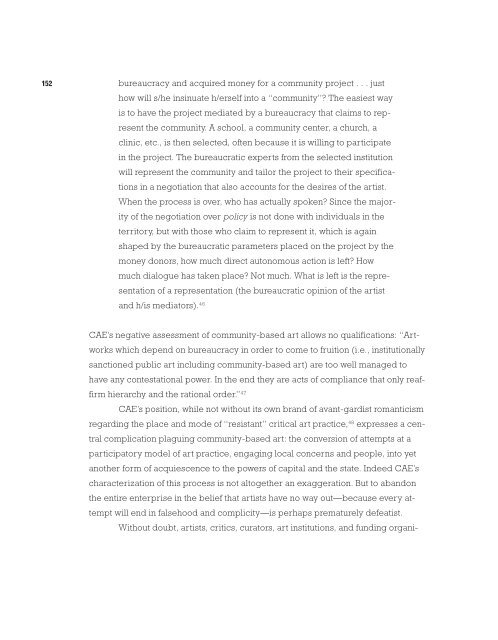ONE PLACE AFTER ANOTHER - Monoskop
ONE PLACE AFTER ANOTHER - Monoskop
ONE PLACE AFTER ANOTHER - Monoskop
You also want an ePaper? Increase the reach of your titles
YUMPU automatically turns print PDFs into web optimized ePapers that Google loves.
152<br />
bureaucracy and acquired money for a community project . . . just<br />
how will s/he insinuate h/erself into a “community”? The easiest way<br />
is to have the project mediated by a bureaucracy that claims to represent<br />
the community. A school, a community center, a church, a<br />
clinic, etc., is then selected, often because it is willing to participate<br />
in the project. The bureaucratic experts from the selected institution<br />
will represent the community and tailor the project to their specifications<br />
in a negotiation that also accounts for the desires of the artist.<br />
When the process is over, who has actually spoken? Since the majority<br />
of the negotiation over policy is not done with individuals in the<br />
territory, but with those who claim to represent it, which is again<br />
shaped by the bureaucratic parameters placed on the project by the<br />
money donors, how much direct autonomous action is left? How<br />
much dialogue has taken place? Not much. What is left is the representation<br />
of a representation (the bureaucratic opinion of the artist<br />
and h/is mediators). 46<br />
CAE’s negative assessment of community-based art allows no qualifications: “Artworks<br />
which depend on bureaucracy in order to come to fruition (i.e., institutionally<br />
sanctioned public art including community-based art) are too well managed to<br />
have any contestational power. In the end they are acts of compliance that only reaffirm<br />
hierarchy and the rational order.” 47<br />
CAE’s position, while not without its own brand of avant-gardist romanticism<br />
regarding the place and mode of “resistant” critical art practice, 48 expresses a central<br />
complication plaguing community-based art: the conversion of attempts at a<br />
participatory model of art practice, engaging local concerns and people, into yet<br />
another form of acquiescence to the powers of capital and the state. Indeed CAE’s<br />
characterization of this process is not altogether an exaggeration. But to abandon<br />
the entire enterprise in the belief that artists have no way out—because every attempt<br />
will end in falsehood and complicity—is perhaps prematurely defeatist.<br />
Without doubt, artists, critics, curators, art institutions, and funding organi-

















